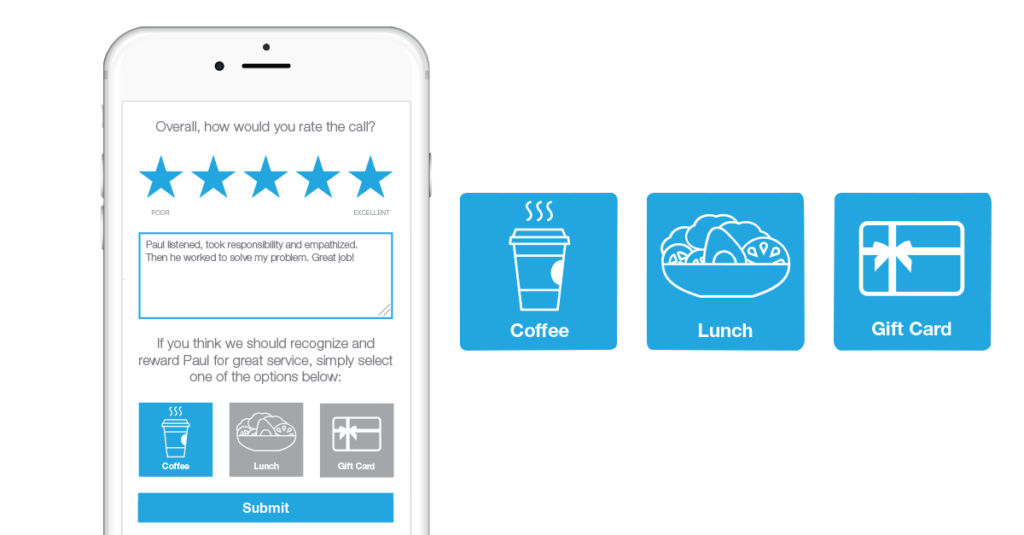How to Design a Call Center Rewards Program
March 30, 2022
Contact Center
Agent engagement is one of the biggest drivers of improving customer service and reducing attrition. Customer service leaders know it’s critical to recognize and reward top performance, but many of them lack a complete rewards program.
In our own conversations with leaders, we’ll hear about challenges related to budgeting a rewards program or just not being able to effectively measure performance.
Nixed the idea of a call center rewards program for similar reasons? Here’s the truth: there is nothing stopping you from recognizing the agents who deliver top-tier service. In fact, your options are limited only by your imagination. Even some of the best, most effective rewards require no investment at all. There’s no ‘right’ way to distribute rewards.
All you need to do is determine which approach is the best fit for your customer service team.
Designing a Call Center Rewards Program: 3 Questions You’ll Need to Address
Ready to motivate your agents? Here’s what you’ll need to consider when designing a call center rewards program from scratch.
1. How should you structure your rewards program?
There are two ways you could go about this: rewarding agents on an individual basis or highlighting team successes. You could combine these approaches, but by and large, you’ll need to choose one or the other.
Both program types have big upsides. If you reward individual agents, they’ll appreciate it more, and it will help with their career progression. If you focus on teams, you’ll encourage friendly competition and create a more cohesive contact center culture.
Deciding which way to go is a matter of priorities, which may change over time.
2. Who will receive rewards?
For many companies, this is the biggest sticking point: not knowing how to establish criteria for recognition and rewards. There are three basic methods for determining who gets what and when, which we’ll describe below.
Agents with the highest QA scores
If agents receive QA scores on a weekly or monthly basis, you could simply pick the person with the highest QA score for a given period. The downside to this method is its impersonal nature. QA scores are often based on metrics such as “Was the agent polite?” and “Did the agent offer to complete the transaction?” Quality measures like these can’t capture an individual agent’s uniquely valuable approach to service.
Team leaders’ subjective picks
Managers might listen to a random sampling of calls, choose the interactions they judge to be the best, and reward agents accordingly. For the agents involved, this is more personal and meaningful than receiving a reward based on a QA score.
But there are two downsides to this method: the subjective nature of picking winners leads to perceptions of bias or favoritism, and the unrepresentative nature of randomly pulled calls. If top performers go unrecognized while other agents bask in glory, morale could take a big hit.
Agents with the highest customer ratings
The third method is to use real-time customer feedback to guide your rewards program. Not only is the data personalized and plentiful, but there’s never any question as to who should receive rewards. The combined benefits of a feedback-based rewards program make it a particularly effective way to drive agent engagement.
3. What types of rewards will you give?
What will serve as rewards depends on both your budgetary constraints and the culture you want to build. If budget isn’t an issue, physical rewards are excellent — a cup of coffee, a free lunch — as are points that accrue and can later be spent on larger rewards such as a five-star dinner for two, a weekend getaway, and airline flights.
You could also offer your own brand’s products, which is a more cost-effective approach. It offers another important benefit as well: firsthand product knowledge that strengthens agents’ brand pride and results in a better service experience for the customer. It’s important, however, to consider the business you’re in. Are your products truly aspirational? If they don’t line up with your agents’ interests and lifestyles, they won’t light a fire under your team.
Job perks make great rewards, too. Give an agent the CEO’s parking spot for a day, a two-hour lunch break, an extra day of vacation, a late start on Monday, or an early dismissal on Friday. These types of rewards don’t cost much if anything at all, but they have tremendous value for employees.

Your fourth option — the least expensive, and sometimes the most meaningful of all— is to give recognition-based rewards. They could take any number of forms: a high five, a callout in a team meeting, or ringing a gong in the call center and leading a round of applause.
You could also enlist senior executives, who aren’t in agents’ everyday orbit, to recognize great performance. The CEO might visit the call center personally, or call or email, to thank an agent for a job well done. This not only leaves a profound and lasting impact on the agent but also elevates the profile of the service team and reminds them they’re making a meaningful contribution.
In a Gallup survey, 28% of employees indicated the most memorable recognition they received came from their manager; 24% of employees cited recognition from the CEO.
When asked which types of recognition were most memorable, respondents ranked physical or monetary rewards near the bottom of the list (fifth out of six).
No matter which way you’re leaning, think creatively. Be daring. Even with limited resources, you can establish a powerful rewards program that energizes your customer service team and keeps them focused on larger brand goals.
Launch the Perfect Call Center Rewards Program
A rewards program can be a powerful motivator on the contact center floor. It also helps create a positive work environment. But it isn’t a cure-all for low morale and lagging performance.
If you’re serious about transforming your contact center culture, boosting agent engagement, and elevating overall service quality, you should combine your rewards program with other initiatives — including customer-driven micro-coaching, customer service training, and QA reviews—to help your agents succeed in their jobs, grow with the company, and distinguish your brand in the marketplace.
Ready to ignite agent performance? Check out Medallia’s guide, 4 Steps to Supercharge Contact Center Agent Performance, to learn how leading contact centers are putting the right systems and processes in place to achieve success.








%20Call%20Center%20Call%20Volume%20%7C%20Agent%20Connect%20%E2%80%93%20Medallia&_biz_n=2&rnd=804886&cdn_o=a&_biz_z=1747241706663)
%20Call%20Center%20Call%20Volume%20%7C%20Agent%20Connect%20%E2%80%93%20Medallia&_biz_n=3&rnd=247408&cdn_o=a&_biz_z=1747241706664)

